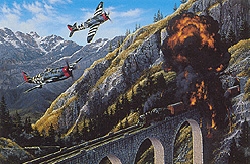|
|
| Bridge Busting Jugs |
|
 |

|
 |
|
|
| DESCRIPTION |
 |
| 16 x 11.5 Inch Collector Size Unframed Lithograph $40.00
Alexander Kartveli was a engineer with Seversky Aircraft who designed the P-35 which first flew in 1937. With Republic Aviation Kartveli supervised the development of the P-43 Lancer. Neither of these aircraft were produced in large numbers and neither was quite successful. However the Republic Aviation P-47 Thunderbolt also nicknamed the "Jug" was quite a different story. The Jug was the jewel in Kartveli's design crown and went on to become one of the most produced fighter aircraft of all time with 15683 being manufactured. The P-47 was the largest and heaviest single seat fighter of WW II. The P-47 immediately demonstrated its excellent combat qualities including speed rate of climb maneuverability heavy fire power and the ability to take a lot of punishment. With a wingspan of more than 40 feet and a weight of 19400 pounds this large aircraft was designed around the powerful 2000 HP Pratt and Whitney R-2800 Double Wasp radial engine. The first P-47 prototype flew in May of 1941 and the primary variant the P-47D went into service in 1943 with units of the U.S. Army's Eighth Air Force. The Jug had a maximum speed in excess of 400 MPH a service ceiling in excess of 42000 feet and was heavily armed with either six or eight heavy caliber machine guns. With its ability to carry up to a 2500 pound bomb load the Jug saw lots of use in ground attack roles. Until the introduction of the "N" model the P-47 lacked the long range required for fighter escort missions which were most often relegated to P-51 Mustangs or P-38 Lightnings. In his outstanding painting entitled Bridge Busting Jugs noted aviation artist Stan Stokes depicts Eighth Air Force Jugs in a ground attack mission in the Alps in June of 1944. The top P-47 ace was Francis Gabreski who had flown with the 56th Fighter Group the first unit to be equipped with the P-47. In August of 1943 Gabreski attained his first aerial combat victory (over an Fw-190) and by year's end he had reached ace status with 8 confirmed victories. As Commander of the 61st Squadron Gabreski continued to chalk up victory after victory and on seven different occasions he achieved two victories during the same mission. However in July of 1944 Gabreski damaged the prop on his Jug during a low level attack on an airfield near Coblenz. Forced to make a crash landing he was captured and remained a prisoner of war until War's end in 1945. Following the War Gabreski returned to military service with the Air Force's 4th Fighter-Interceptor Wing in Korea. Flying the F-86 Sabre Jet Gabreski attained 6.5 more aerial victories in 1951 and 1952 becoming an ace in two different wars. |
|


|